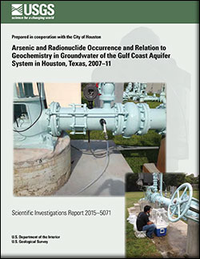Arsenic and radionuclide occurrence and relation to geochemistry in groundwater of the Gulf Coast Aquifer System in Houston, Texas, 2007–11
Links
- Document: Report (3.38 MB pdf)
- Appendix: Appendixes 1–4 (428 kB pdf)
- Download citation as: RIS | Dublin Core
Abstract
The U.S. Geological Survey (USGS), in cooperation with the City of Houston, began a study in 2007 to determine concentrations, spatial extent, and associated geochemical conditions that might be conducive for mobility and transport of selected naturally occurring trace elements and radionuclides in the Gulf Coast aquifer system in Houston, Texas. Water samples were collected from 91 municipal supply wells completed in the Evangeline and Chicot aquifers of the Gulf Coast aquifer system in northeastern, northwestern, and southwestern Houston; hereinafter referred to as northeast, northwest and southwest Houston areas. Wells were sampled in three phases: (1) 28 municipal supply wells were sampled during 2007–8, (2) 60 municipal supply wells during 2010, and (3) 3 municipal supply wells during December 2011. During each phase of sampling, samples were analyzed for major ions, selected trace elements, and radionuclides. At a subset of wells, concentrations of arsenic species and other radionuclides (carbon-14, radium-226, radium-228, radon-222, and tritium) also were analyzed. Selected physicochemical properties were measured in the field at the time each sample was collected, and oxidation-reduction potential and unfiltered sulfides also were measured at selected wells. The source-water (the raw, ambient water withdrawn from municipal supply wells prior to water treatment) samples were collected for assessment of aquifer conditions in order to provide community water-system operators information that could be important when they make decisions about which treatment processes to apply before distributing finished drinking water.
Geochemical conditions of groundwater of the Gulf Coast aquifer system are suitable in some instances for release of arsenic and radionuclides from aquifer materials. Recent changes to the U.S. Environmental Protection Agency (EPA) primary drinking-water regulations for arsenic and a selected number of natural radionuclides have highlighted the necessity for municipal supply system managers to be aware of the occurrence and distribution of these constituents in their source water. Concentrations of arsenic ranged from 0.58 to 23.5 micrograms per liter (μg/L), with relatively low median and 75th percentile concentrations (2.7 and 3.6 μg/L, respectively). The gross alpha-particle activity completed within 72 hours after sample collection ranged from R-1.1 (nondetect where the result was below the sample specific critical level) to 39.7 picocuries per liter (pCi/L), with a median of 10.3 pCi/L. After 30 days, the gross alpha-particle activities in the 91 samples ranged from R-0.94 to 25.5 pCi/L, with a median of 5.60 pCi/L. Concentrations of uranium ranged from less than 0.02 to 42.7 μg/L, with a median value of 1.69 μg/L and a 75th-percentile value of 6.48 μg/L. The maximum concentrations of radium-226 and combined radium (sum of radium-226 plus radium-228) were 4.34 pCi/L and 3.23 pCi/L, respectively.
Aquifer major-ion geochemistry was characterized and shown to contain three chemical types of water as grouped by a simplified predominant cation and anion classification system: (1) calcium- bicarbonate type, (2) sodium-bicarbonate type, and (3) sodium-chloride type. Aquifer geochemistry also was characterized into four reduction-oxidation (redox) categories: (1) oxic, (2) suboxic, (3) mixed, and (4) anoxic. Within the anoxic category, groundwater was further characterized into four presumed predominant reduction processes: (1) iron or sulfate or both [Fe(III)/SO4] reducing, (2) iron [Fe(III)] reducing, (3) iron and sulfate [Fe(III)-SO4] reducing, or (4) methanogenic, as defined by composition of redox species. The oxic category was associated with calcium-bicarbonate-type water, and the methanogenic-anoxic process was associated exclusively with the sodium-bicarbonate-type water. The species of arsenic and the dominant radionuclide present were associated with specific redox categories. Arsenate was associated primarily with oxic water and did not exceed 3.5 µg/L, whereas arsenite was associated with iron-reducing, anoxic water samples and, at the highest concentrations, occurred in sulfate-reducing, anoxic; methanogenic-anoxic; or both water samples. Uranium was associated exclusively with the oxic water, whereas the highest concentrations of combined radium were associated with the iron-reducing, anoxic water. The gross alpha-particle activity was greatest in the oxic waters where the source of the radioactivity was the uranium.
Associated geochemical conditions conducive for mobility of arsenic and radionuclides and their spatial and vertical extent in the Gulf Coast aquifer system in Houston are important aspects to the areal management of the municipal groundwater supplies in Houston. Ongoing research is seeking to define chemical or geological factors that are the optimal indicators for elevated concentrations of these naturally occurring constituents.
Suggested Citation
Oden, J.H., and Szabo, Zoltan, 2015, Arsenic and radionuclide occurrence and relation to geochemistry in groundwater of the Gulf Coast Aquifer System in Houston, Texas, 2007–11: U.S. Geological Scientific Investigations Report 2015–5071, 105 p., 4 apps., https://dx.doi.org/10.3133/sir20155071.
ISSN: 2328-0328 (online)
Study Area
Table of Contents
- Acknowledgements
- Abstract
- Introduction
- Geochemistry
- Arsenic Occurrence
- Radionuclide Occurrence
- Relations Among Trace Elements, Radionuclides, and Geochemistry
- Implications for Occurrence of Arsenic and Radionuclides in the Gulf Coast Aquifer System
- Summary
- References Cited
| Publication type | Report |
|---|---|
| Publication Subtype | USGS Numbered Series |
| Title | Arsenic and radionuclide occurrence and relation to geochemistry in groundwater of the Gulf Coast Aquifer System in Houston, Texas, 2007–11 |
| Series title | Scientific Investigations Report |
| Series number | 2015-5071 |
| DOI | 10.3133/sir20155071 |
| Publication Date | March 21, 2016 |
| Year Published | 2016 |
| Language | English |
| Publisher | U.S. Geological Survey |
| Publisher location | Reston, VA |
| Contributing office(s) | Texas Water Science Center |
| Description | Report: xi, 105 p.; Appendixes: 29 p. |
| Country | United States |
| State | Texas |
| City | Houston |
| Online Only (Y/N) | Y |
| Additional Online Files (Y/N) | N |


